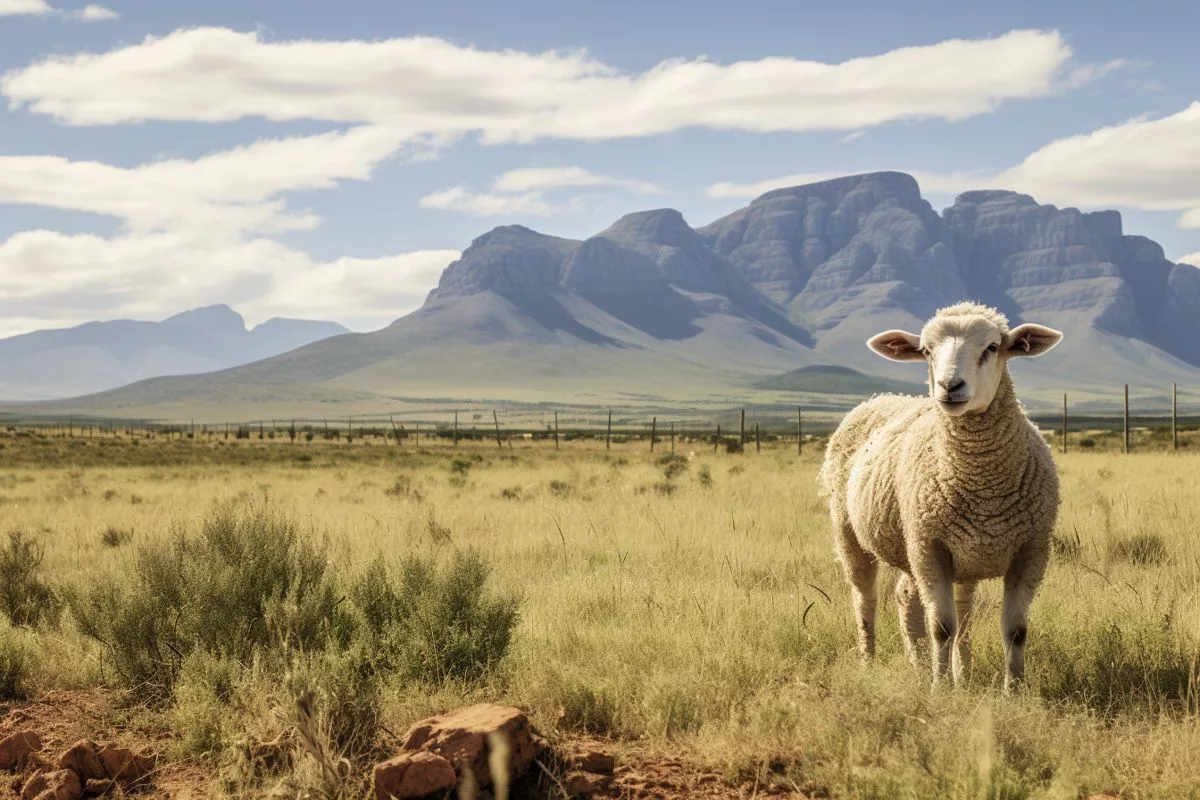Karoo Lamb, a unique lamb offering from South Africa’s Karoo region, has become the first South African product to be registered as a Geographical Indication (GI) under the nation’s Agricultural Products Standards Act. This registration ensures that financial and reputational rewards are directed back to the region and maintains the high quality and standards for which it is renowned. Karoo Lamb’s journey towards GI registration required years of cooperation among various stakeholders and the product’s unique features have been the focus of comprehensive research. The GI registration serves multiple purposes beyond simply recognizing this specific product, as it also secures the reputation of Karoo Lamb and ensures that financial and reputational rewards are directed back to the region.
What is Karoo Lamb and why is it significant?
Karoo Lamb is a unique lamb offering from South Africa’s Karoo region. It has recently become the first South African product to be registered as a Geographical Indication (GI) under the nation’s Agricultural Products Standards Act. Karoo Lamb’s GI registration ensures that financial and reputational rewards are directed back to the region, and maintains the high quality and standards for which it is renowned.
The Karoo Lamb’s Road to Recognition
The expansive, semi-arid terrain of South Africa’s Karoo region has long captivated the imagination of individuals seeking to experience its unparalleled biodiversity and gastronomic treasures. One such treasure, Karoo Lamb, has recently reached an extraordinary milestone: it has become the first South African product to be registered as a Geographical Indication (GI) under the nation’s Agricultural Products Standards Act. This significant accomplishment has been celebrated by local authorities and residents, primarily due to the potential financial and reputational benefits it promises for the region.
The journey towards GI registration for Karoo Lamb has been a challenging one. Its unique features have been the focus of comprehensive research, leading to an abundance of scientific evidence that highlights its distinctiveness. Dr. Dirk Troskie, the Director of Business Planning and Strategy with the Western Cape Department of Agriculture, states that the Karoo’s geology, rainfall patterns, harsh climate, and exceptional vegetation contribute to the lamb and mutton’s distinguishable sensory characteristics. Research has shown that the area’s grazing plants impart herbal and musty flavors to the meat, an attribute that has contributed to its global reputation.
Achieving registration required years of cooperation among various stakeholders, such as the Karoo Lamb Consortium, Western and Northern Cape Provinces, the Universities of Pretoria and Stellenbosch, and the French Agricultural Research Centre for International Development (CIRAD). Collectively, these institutions assisted local farmers in creating the product description and implementing the necessary systems to protect and promote Karoo Lamb.
Impact and Benefits of GI Registration
The GI registration serves multiple purposes beyond simply recognizing this specific product; it also secures the reputation of Karoo Lamb and ensures that financial and reputational rewards are directed back to the region. The central geographical area encompassed by the GI registration covers 19.33 million hectares of grazing land, including towns such as Beaufort West, Laingsburg, and Prince Albert.
In order to qualify as Karoo Lamb, animals must be raised on farms located within the designated Karoo region, grazing freely on the veld. Additionally, abattoirs are required to provide proof of origin through traceability systems, ensuring that animals received from registered and listed owners originate from the defined area. These measures will aid in maintaining the high quality and standards for which Karoo Lamb is renowned.
Dr. Ivan Meyer, the Western Cape MEC of Agriculture, has expressed his appreciation to those who contributed to the achievement of Karoo Lamb’s GI registration. He believes that this is just the beginning for the Karoo region, with numerous opportunities for other producers to follow in their footsteps. Eventually, other regions such as the Hantam, Klein Karoo, and Overberg may also gain recognition for their unique lamb offerings.
A Bright Future for Karoo Lamb and South Africa
As the first South African product to attain GI registration, Karoo Lamb stands as an inspiring example of the potential hidden within this diverse and stunning country. The path towards this significant achievement has been marked by rigorous research, collaborative efforts, and a profound appreciation for the region’s distinctive offerings. The result is not only a testament to the culinary prowess of South African producers but also a celebration of the rich tapestry of natural and cultural wonders that make the Karoo region truly extraordinary.
In the end, the GI registration of Karoo Lamb signifies more than just the protection of a product; it embodies a narrative that weaves together the lives of the people who inhabit the region, the land they call home, and the incredible flavors that emerge from their symbiotic relationship. As the world continues to uncover the culinary treasures that South Africa has to offer, Karoo Lamb stands as a proud and delectable symbol of the unique convergence of geography, culture, and taste that distinguishes this remarkable nation.
1. What is Karoo Lamb and why is it significant?
Karoo Lamb is a unique lamb offering from South Africa’s Karoo region. It has recently become the first South African product to be registered as a Geographical Indication (GI) under the nation’s Agricultural Products Standards Act. Karoo Lamb’s GI registration ensures that financial and reputational rewards are directed back to the region, and maintains the high quality and standards for which it is renowned.
2. What is a Geographical Indication?
A Geographical Indication (GI) is a form of intellectual property that recognizes products originating from a specific geographical location. It serves to protect the reputation and quality of the product, and to ensure that financial and reputational rewards are directed back to the region of origin.
3. What makes Karoo Lamb unique?
Karoo Lamb’s unique characteristics have been the focus of comprehensive research. The Karoo’s geology, rainfall patterns, harsh climate, and exceptional vegetation contribute to the lamb and mutton’s distinguishable sensory characteristics. Grazing plants in the area impart herbal and musty flavors to the meat, an attribute that has contributed to its global reputation.
4. How long did it take for Karoo Lamb to achieve GI registration?
Achieving registration required years of cooperation among various stakeholders, such as the Karoo Lamb Consortium, Western and Northern Cape Provinces, the Universities of Pretoria and Stellenbosch, and the French Agricultural Research Centre for International Development (CIRAD).
5. What are the benefits of GI registration for Karoo Lamb?
The GI registration serves multiple purposes beyond simply recognizing this specific product; it also secures the reputation of Karoo Lamb and ensures that financial and reputational rewards are directed back to the region. This will aid in maintaining the high quality and standards for which Karoo Lamb is renowned.
6. What are the requirements for Karoo Lamb to be considered as such?
In order to qualify as Karoo Lamb, animals must be raised on farms located within the designated Karoo region, grazing freely on the veld. Additionally, abattoirs are required to provide proof of origin through traceability systems, ensuring that animals received from registered and listed owners originate from the defined area.
7. What is the central geographical area encompassed by the GI registration?
The central geographical area encompassed by the GI registration covers 19.33 million hectares of grazing land, including towns such as Beaufort West, Laingsburg, and Prince Albert.
8. Will other regions in South Africa follow in Karoo Lamb’s footsteps and gain recognition for their unique offerings?
Dr. Ivan Meyer, the Western Cape MEC of Agriculture, believes that this is just the beginning for the Karoo region, with numerous opportunities for other producers to follow in their footsteps. Eventually, other regions such as the Hantam, Klein Karoo, and Overberg may also gain recognition for their unique lamb offerings.








